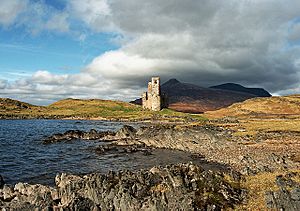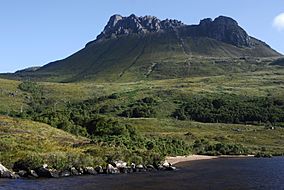Assynt facts for kids
Quick facts for kids Assynt
|
|
|---|---|
 Ardvreck Castle |
|
| Population | 1,011 |
| OS grid reference | NC2092 |
| • Edinburgh | 234 mi (377 km) |
| • London | 637 mi (1,025 km) |
| Council area | |
| Lieutenancy area | |
| Country | Scotland |
| Sovereign state | United Kingdom |
| Post town | Lairg |
| Dialling code | 01571 |
| Police | Northern |
| Fire | Highlands and Islands |
| Ambulance | Scottish |
| EU Parliament | Scotland |
| UK Parliament |
|
| Scottish Parliament |
|
Assynt (Scottish Gaelic: Asainn or Asainte) is a beautiful area in the southwest of Sutherland, a region in Scotland. It's located on the west coast, north of Ullapool. Assynt is famous for its amazing landscape and unique mountains. Because of its beauty, Assynt and its neighbor, Coigach, are part of the Assynt-Coigach National Scenic Area. This is one of 40 special areas in Scotland protected for their natural beauty.
The western part of Assynt has many mountains with cool shapes, like Quinag, Canisp, Suilven, and Ben More Assynt. These mountains rise steeply from the flat land around them, which is dotted with small hills and lakes (called "cnoc and lochan" scenery). They often look much taller than they are because of their steep sides. Many of these peaks, like Suilven, were formed during the last Ice Age. They stood out above the ice sheet like islands, and now they are like rocky "islands" of sandstone sitting on much older rock called Lewisian gneiss. You can see important rock formations at Knockan Crag National Nature Reserve, which has a visitor center to explain the geology. In eastern Assynt, there's an area with limestone rocks around Ben More Assynt. This is where you'll find Scotland's longest cave, Uamh an Claonaite, near Inchnadamph. Assynt's important geology is why it's part of the North West Highlands Geopark.
The name Assynt might come from an Old Norse word meaning 'ridge end'. There's also a story that the name came from a fight between two brothers, Unt (meaning Man of Peace) and Ass-Unt (meaning Man of Discord). The story says Ass-Unt won and gave his name to the area.
Contents
Assynt's Local Government and History
For many years, Assynt was its own special area in Scotland. Later, it became a "civil parish," which is like a local district. When counties were created, Assynt became part of Sutherland county. Today, Assynt is a "community" within the Highland council area. This means it has its own local community council that helps manage local affairs.
Who Owns the Land in Assynt?
Like many parts of the Scottish highlands, Assynt is divided into several large land areas called estates. These estates are owned by different groups: some are private, some are owned by charities, and some are owned by the local community. The Assynt Estate, which includes Ben More Assynt and the land around Lochinver, is still owned by the Vestey family.
The Quinag estate is owned by the John Muir Trust. This charity works to protect wild land and natural places.
The Little Assynt Estate, which includes two old villages called Little Assynt and Loch Beannach, is now owned by the Culag Community Woodland Trust. This local trust helps create jobs, offers training, and improves life for local people. It also helps teach people about the area's natural environment.
North Assynt: A Community Buys Its Land

In 1989, a part of the Assynt estate was put up for sale by the Vestey family. This area was mostly made up of "crofting" land, where small farms (crofts) were set up long ago. The owners wanted to sell it to buy more land for deer hunting. A company called Scandinavian Property Services Limited bought the land.
Three years later, this company had financial problems and decided to sell the land in seven separate pieces. This worried the local crofters (farmers). The new boundaries cut across their shared grazing land, meaning some crofters might have to deal with many different landlords. The crofters decided to try and buy the land themselves.
The Assynt Crofters' Trust was formed to raise money and buy the estate. Members of the trust were crofters from the area. Their goal was to own the land and manage it themselves. They also wanted to start projects like building houses, creating jobs, and planting trees. Money came from many places:
- Each crofting family tried to raise £1,000.
- Local and national organizations, like Caithness and Sutherland Enterprise and Scottish Natural Heritage, gave grants.
- The Highland Regional Council also donated money.
- A lot of money came from a public appeal, raising over £130,000 from people all over the world. Even famous people and the band Runrig donated!
The trust made a few offers that were not accepted. So, they decided to try a different approach. They used a special law that allowed crofters to buy their crofts. This made the land less attractive to other buyers.
Finally, on December 4, 1992, the trust made a final offer of £300,000. It was accepted! On February 1, 1993, the Assynt Crofters' Trust became the owners of the land, which they renamed the North Assynt Estate. This was a huge success for community ownership in Scotland.
Glencanisp and Drumrunie Estate: Another Community Purchase
In June 2005, the local community bought the Glencanisp estate, which includes the mountains Suilven and Canisp. They also bought the nearby Drumrunie estate, with mountains like Cùl Mòr and Cùl Beag. The Assynt Foundation now manages these estates, which cover about 18,000 hectares. Their goal is to create local jobs, protect the natural and cultural heritage for future generations, and make sure everyone can enjoy the area.
Nature and Wildlife in Assynt
| Assynt-Coigach National Scenic Area | |
|---|---|

Stac Pollaidh
|
|
| Location | Highland, Scotland |
| Area | 1,298 km2 (501 sq mi) |
| Established | 1981 |
| Governing body | NatureScot |
Assynt has many different types of natural environments, called habitats. These include rocky and sandy coastlines, high mountains, woodlands, and areas with small plants like juniper bushes. The area has many freshwater lakes (lochs) where you can see birds like black-throated divers.
The rocky coastline is a great home for many seabirds. It's also one of the best places in Europe to see cetaceans, which are sea mammals like whales, dolphins, and porpoises. In the mountains, you might spot Ptarmigan birds and even golden eagles. Besides many red deer, other animals in Assynt include mountain hares, water voles, otters, and small pipistrelle bats.
The Coigach and Assynt Living Landscape Project is a special partnership. It brings together landowners, local communities, and charities like the Scottish Wildlife Trust. This project aims to improve the environment and economy in the area. It works to connect woodlands, bring back diverse plants and animals, and help the Scottish uplands grow.
A large part of Assynt, called Inverpolly, used to be a national nature reserve. Now, the reserve focuses on the area around Knockan Crag. Inverpolly is also a Special Area of Conservation, which means it's protected for its important habitats and species. There are two other Special Areas of Conservation in Assynt: Inchnadamph and Ardvar and Loch a' Mhuilinn Woodlands. Many of the lochs are also protected as Special Protection Areas for birds.
Towns and Villages in Assynt
Here are some of the communities you can find in Assynt:
- Achmelvich
- Ardvar
- Balchladich
- Clachtoll
- Clashmore
- Clashnessie
- Culkein
- Culkein Drumbeg
- Drumbeg
- Elphin
- Glencoul
- Inchnadamph
- Inverkirkaig
- Kylesku
- Lochinver
- Nedd
- Raffin
- Stoer
Images for kids
-
Suilven from the air, showing the steep-sided mountain slopes and rough moorland landscape typical of Assynt.
See also
 In Spanish: Assynt para niños
In Spanish: Assynt para niños







